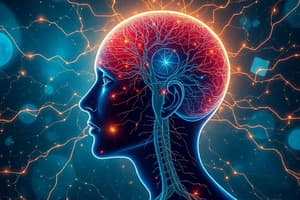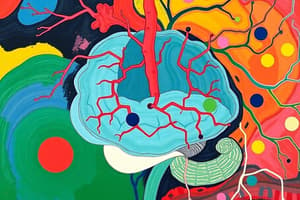Podcast
Questions and Answers
What type of nervous tissue primarily contains cell bodies and dendrites?
What type of nervous tissue primarily contains cell bodies and dendrites?
- Myelinated tissue
- Gray matter (correct)
- Spinal cord tissue
- White matter
How does white matter primarily function in the central nervous system?
How does white matter primarily function in the central nervous system?
- It facilitates voluntary control.
- It processes sensory information.
- It stores memory.
- It carries information to and from the brain. (correct)
What is the primary consequence of damage in the thoracic region of the spinal cord?
What is the primary consequence of damage in the thoracic region of the spinal cord?
- Paraplegia (correct)
- Quadriplegia
- Loss of fine motor skills
- Sensory deprivation in the arms
Which structure serves as the largest part of the brain?
Which structure serves as the largest part of the brain?
What type of axons are found predominantly in white matter?
What type of axons are found predominantly in white matter?
In a cross section of the spinal cord, where is white matter located?
In a cross section of the spinal cord, where is white matter located?
What does quadriplegia result from?
What does quadriplegia result from?
What type of axons does gray matter predominantly contain?
What type of axons does gray matter predominantly contain?
Which type of neuron carries nerve signals from a sensory receptor to the CNS?
Which type of neuron carries nerve signals from a sensory receptor to the CNS?
What role do interneurons play in the nervous system?
What role do interneurons play in the nervous system?
Which structure of the neuron contains the nucleus and other organelles?
Which structure of the neuron contains the nucleus and other organelles?
What is the primary function of a motor neuron?
What is the primary function of a motor neuron?
Which part of a neuron is primarily responsible for conducting nerve impulses?
Which part of a neuron is primarily responsible for conducting nerve impulses?
What are individual axons referred to as?
What are individual axons referred to as?
What do dendrites do in a neuron?
What do dendrites do in a neuron?
Which statement correctly describes efferent neurons?
Which statement correctly describes efferent neurons?
What is the primary function of the somatic system?
What is the primary function of the somatic system?
Which component initiates the reflex arc response?
Which component initiates the reflex arc response?
What is the role of the sympathetic division within the autonomic system?
What is the role of the sympathetic division within the autonomic system?
What physiological state does the parasympathetic division promote?
What physiological state does the parasympathetic division promote?
Which is true regarding reflex actions?
Which is true regarding reflex actions?
How do interneurons function in the reflex arc?
How do interneurons function in the reflex arc?
What effect does the sympathetic division have on digestive organs?
What effect does the sympathetic division have on digestive organs?
Which of the following statements is true about voluntary and involuntary actions in the somatic system?
Which of the following statements is true about voluntary and involuntary actions in the somatic system?
What is the term used for the minimum voltage that must be reached for an action potential to occur?
What is the term used for the minimum voltage that must be reached for an action potential to occur?
During depolarization in an action potential, which ion primarily rushes into the cell?
During depolarization in an action potential, which ion primarily rushes into the cell?
What characteristic of action potentials indicates that they do not vary in size?
What characteristic of action potentials indicates that they do not vary in size?
What happens during the repolarization phase of an action potential?
What happens during the repolarization phase of an action potential?
Which of the following statements about action potentials is false?
Which of the following statements about action potentials is false?
What restores the resting potential at the end of an action potential?
What restores the resting potential at the end of an action potential?
Which of the following describes the effect of increasing the stimulus strength on the action potential?
Which of the following describes the effect of increasing the stimulus strength on the action potential?
Where do action potentials occur in the neuron?
Where do action potentials occur in the neuron?
What is the primary effect of alcohol on the brain?
What is the primary effect of alcohol on the brain?
What long-term effect does nicotine have on the body after initial use?
What long-term effect does nicotine have on the body after initial use?
What percentage of individuals trying nicotine are likely to become addicted?
What percentage of individuals trying nicotine are likely to become addicted?
What is the typical duration of the euphoria experienced from cocaine use?
What is the typical duration of the euphoria experienced from cocaine use?
What is a common follow-up feeling after the initial effects of methamphetamine wear off?
What is a common follow-up feeling after the initial effects of methamphetamine wear off?
Which of the following is a significant health effect of long-term nicotine use?
Which of the following is a significant health effect of long-term nicotine use?
Which neurotransmitter is primarily associated with nicotine's reinforcing effects?
Which neurotransmitter is primarily associated with nicotine's reinforcing effects?
What psychiatric effects can follow the use of cocaine and crack?
What psychiatric effects can follow the use of cocaine and crack?
Flashcards are hidden until you start studying
Study Notes
Somatic System
- Serves the skin and skeletal muscles
- Somatic motor actions can be voluntary or involuntary
- Reflexes are automatic responses to stimuli
Reflex Arc
- Sensory neurons enter the spinal cord and stimulate interneurons.
- Interneurons synapse with motor neurons.
- Motor neurons transmit signals to effectors, triggering a response to the stimulus.
- Some interneurons relay signals to the brain for perception.
Autonomic System
- Regulates cardiac and smooth muscles, organs, and glands.
- Divided into the sympathetic and parasympathetic divisions.
- Both divisions create opposing responses and are involuntary.
- Innervate all internal organs.
Sympathetic Division
- Active during emergency situations (fight or flight).
- Increases heart rate and dilates airways for oxygen and glucose supply.
- Inhibits digestive and urinary functions.
Parasympathetic Division
- Promotes relaxation and rest.
- Enhances digestion and slows heart rate.
- Often called the 'rest-and-digest' system.
Gray and White Matter
- Central Nervous System (CNS) consists of gray and white matter.
- Gray matter contains cell bodies, dendrites, and short, unmyelinated axons.
- White matter contains myelinated axons.
Structure of the Spinal Cord
- Cross-section shows a central canal, gray matter, and white matter.
- Spinal nerves extend from the cord.
- White matter surrounds gray matter and carries information to and from the brain.
Functions of the Spinal Cord
- Paralysis is a loss of sensation and voluntary control.
- Paraplegia occurs with damage in the thoracic region, paralyzing lower body and legs.
- Quadriplegia occurs with damage in the neck region, affecting all four limbs.
The Brain
- Composed of the cerebrum, diencephalon, cerebellum, and brain stem.
- Cerebrum is the largest part of the brain.
Anatomy of a Neuron
- Sensory, inter, and motor neurons based on function.
- Sensory neuron carries signals from sensory receptors to the CNS.
- Sensory receptors detect environmental changes.
Anatomy of a Neuron, continued
- Interneurons are found only within the CNS.
- They receive input from sensory neurons and other interneurons.
- Interneurons process signals and communicate with motor neurons.
Anatomy of a Neuron, continued
- Motor neuron carries signals from the CNS to effectors (muscle fibers, organs, or glands).
- Effectors carry out responses to environmental changes.
Anatomy of a Neuron, continued
- Neurons have cell body, dendrites, and an axon.
- Cell body contains nucleus and other organelles.
- Dendrites are short extensions that receive signals from receptors or other neurons.
Anatomy of a Neuron, continued
- Axon conducts nerve impulses.
- Individual axons are called nerve fibers and collectively form a nerve.
Action Potential
- Nerve signals are action potentials.
- Occur only in axons.
- A stimulus activates the neuron, E.g., a pinprick on skin for pain neurons.
- Threshold is the minimum voltage required for an action potential (-55 mV).
Action Potential Continued
- Action potentials are "all-or-nothing".
- Once threshold is reached, the action potential completes.
- Increasing stimulus strength does not change action potential size.
Action Potential, continued
- Depolarization: The first part of an action potential.
- Na+ channels open and Na+ rushes into the cell, making the inside positive.
- Repolarization: The second part of an action potential.
- Na+ channels close and K+ channels open, letting K+ flow out of the cell, making the inside negative again.
- The sodium-potassium pump restores resting potential by returning K+ inside and Na+ outside.
Alcohol
- Depressant on the brain.
- Effects include relaxation, lowered inhibitions, impaired coordination, slurred speech, and vomiting.
- High blood alcohol levels can lead to coma or death.
Nicotine
- Raises blood sugar, but the drop afterward causes cravings.
- Stimulates dopamine release in pleasure centers, creating temporary pleasure.
- 70% of users become addicted, and only 10-20% can quit.
- Causes serious cardiovascular and respiratory diseases.
Cocaine and Crack
- Powerful stimulant.
- Produces a short-lived sense of well-being, followed by fatigue, depression, and irritability.
Methamphetamine and Ecstasy
- Powerful stimulant often produced illicitly.
- Creates euphoria, energy, alertness, and elevated mood.
- Followed by agitation and sometimes violent behavior.
Studying That Suits You
Use AI to generate personalized quizzes and flashcards to suit your learning preferences.




